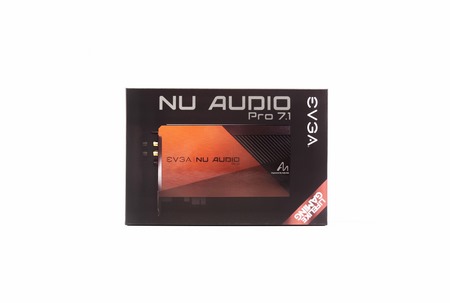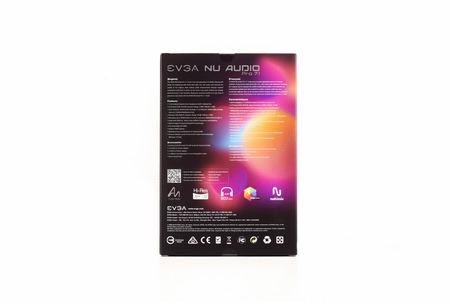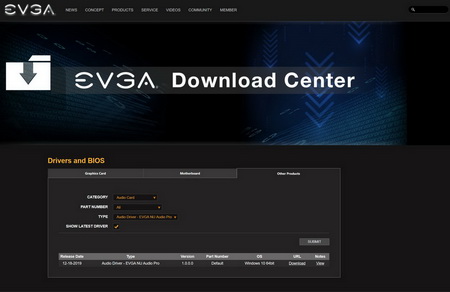INTRODUCTION
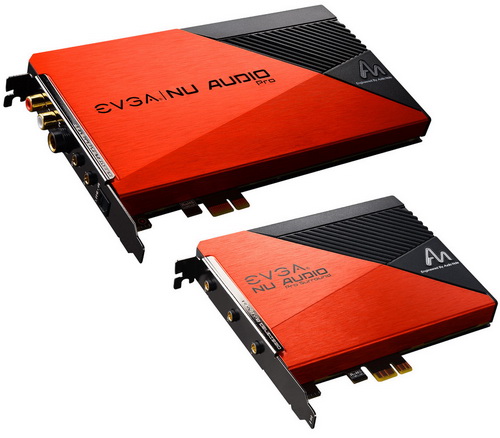
Largely thanks to the cooperation between EVGA and Audio Note UK the PC audio market has become a lot more exciting as of late. Sure, after many decades in the market Creative is still the number one manufacturer of audio cards (both internal and external models) for the PC (and is still leading in terms of sales) but competition is always good for consumers and that's exactly what EVGA brought to the table with their NU Audio Premium Sound Card model last year (review here). Over the years EVGA established themselves as one of NVIDIA's and Intel's most trusted and reliable partners not only because of their high-performance graphics cards and mainboards but also their excellent after sales support so when they entered the PC audio market last year many people thought it was a one-time deal. Today with us we have the latest addition in their line-up called the NU Audio Pro 7.1 and so it would seem that EVGA is really serious about also establishing themselves in the high-end/audiophile PC audio market.
EVGA is the #1 NVIDIA authorized partner in channel sales throughout North America. Based on the philosophy of intelligent innovation, market knowledge, and the real time operation, EVGA continues to identify the need in the market place and providing the solution to that need. By offering product differentiation, a 90 day Step-Up program, and other customer focused programs, EVGA is a clear leader in all categories: etail, retail, distribution, and system builders. With headquarters in Brea, CA, EVGA's global coverage includes EVGA GmbH in Munich, EVGA LATAM in Miami, and EVGA Hong Kong. For further information online about EVGA, visit https://www.evga.com.
EVGA announced their NU Audio Pro 7.1 cards (set and two separate cards) roughly 2 months ago and as clearly stated by its name this is their very first sound card to also support 7.1 surround sound, analog that is. As some of you are well aware the very first NU Audio Card was (still is) not only an audiophile targeted model (thanks to its XMOS xCORE-200 32-bit multicore microcontroller, the AK4493 and the AK5572 converters and the swappable OP-AMPs) but it did support 5.1 surround sound via its digital optical output (SPDIF) which allowed the end user to connect it with a compatible surround sound system (usually to an audio/video amplifier). Now even though the new NU Audio Pro card uses the same microcontroller by XMOS it does take things a step further compared to its predecessor, not only due to fine-tuning and its higher-performance hardware components (including Seiryu capacitors by Audio Note and the UKLT1469 op-amp) but also due to the addition of a small expansion card (connect together via mini DisplayPort) which ads a total of 3 analog outputs (3.5mm) to the mix for analog surround sound support. So, this time over the NU Audio Pro card is not only also Hi-Res Audio certified and features Nahimic 3D audio enhancements but supports playback formats up to 384kHz/32bit for stereo (2.0), 192KHz/24bit via the optical output (5.1) and 192kHz/32bit for Multi-Channel (4.0/5.1/7.1). Other features include customizable RBG lighting (6 modes / audio reactive), newly designed front metal shroud, EMS shielding backplate, copper shielding and gold plated outputs.
SPECIFICATIONS AND FEATURES

PACKAGING AND CONTENTS
The new NU Audio Pro 7.1 surround sound card arrived inside a black box that has the company logo at the front and a large product picture.
At the top you can see both cards included in the bundle from the top.
A few words about the product along with the features and accessories lists are printed at the rear in 2 languages.
Since we received the complete set both cards are placed in formed pieces of plastic (the expansion card is placed beneath the main board).
Along with the two cards you're also getting the mini DisplayPort cable, gold plated 6.3mm to 3.5mm adapter, dual RCA/component (male) to single 3.5mm adapter and the user manual.
THE NU AUDIO PRO 7.1
The NU Audio Pro card comes with a newly designed orange and black front metal cover which looks nice (even though i slightly prefer the one of the NU Audio model placed right next to it for comparison purposes).
Both the NU Audio and the NU Audio Pro feature the same analog and optical outputs as seen above.
Another "extra" feature of the new NU Audio Pro is the EMS shielding backplate which the NU Audio card lacks.


The Audio Note UK logo and the Designed by EVGA tag are both placed on the card just like with the NU Audio model.
Here you can see the audio 3.5mm analog audio outputs of the expansion card.

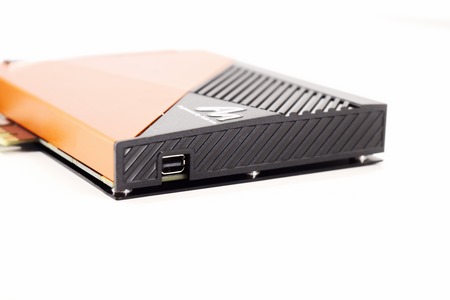 In terms of power connectors only the NU Audio Pro has need of a SATA one (directly from your PSU, not via a Molex adapter), the analog surround card just has the mini DisplayPort connector.
In terms of power connectors only the NU Audio Pro has need of a SATA one (directly from your PSU, not via a Molex adapter), the analog surround card just has the mini DisplayPort connector.
Of course, even the expansion card has a rear EMS shielding backplate.

 At the top of the NU Audio Pro card we see the 10 mode multi-zone audio reactive RGB lighting system (completely different compared to that of the NU Audio model).
At the top of the NU Audio Pro card we see the 10 mode multi-zone audio reactive RGB lighting system (completely different compared to that of the NU Audio model).
INTERNAL COMPONENTS
Removing the front and rear covers of the NU Audio Pro 7.1 cards was the next step.


In the above pictures you can see the standard (black/gold), Seiryu (blue), WIMA (red) and Panasonic (blue/gold) capacitors and the specialized resistors.



Here we see the AD8056 and LT1469 OP-AMPS by ADI and the xCORE-200 microcontroller by XMOS.


Next, we have the ASMedia USB controller and the audio A/D converters by AKM.


Above we have the 7.1 analog expansion card with its standard Audio Note UK (black/gold), Seiryu (blue), WIMA (red) and Panasonic (blue/gold) capacitors and the specialized resistors standing out.


We also see solid state capacitors by Nichicon, 3 OP275 OP-AMPS by ADI and 3 audio A/D converters by AKM.
AUDIO DRIVER
You can grab the latest software/driver version from the official EVGA support page seen above (since the card is brand new the software package is still at version 1.0).
Strangely enough however a new firmware version was available for our card (installation takes less than a minute to complete).




Unlike the software for the NU Audio card that of the NU Audio Pro 7.1 card allows you to set the volume levels of each of the analog connected speakers (you will need to choose your configuration of course), the digital SPDIF output, the headphones output (each channel) and the microphone input (there's also a useful boost function here).



You can also change the sample rate (up to 192kHz/32bit max for multi-channel seen above), enable hi-res mode for your stereo speakers (up to 384kHz/32bit) and use one of the available audio effects for your output (3D audio/reverb/compressor) and input (volume stabilizer/volume reduction).
By clicking on the left and right arrows you can move to the 2nd screen from where you can access the bass, treble boost and voice clarity wheels.
If the quick adjust wheels don't do the trick for you there's always the advanced tab from where you can fine tune audio via an equalizer which then you can save in the 6 available presets/profiles.

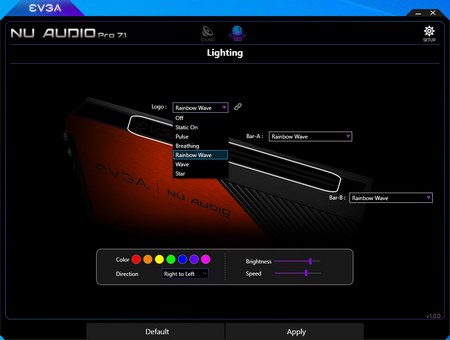
By clicking on the LED selection at the top you can assign one of the 10 available modes to each of the three available RGB LED zones (unfortunately just like the NU Audio model the Pro 7.1 model doesn't come with support for RGB sync).
The next screen allows the end user to change the language of the software, check the installed firmware version and have the software screen minimize at start.



Next screen includes various settings such as the preferred ASIO buffer size, safe mode (enabled by default - slightly increases latency when enabled) and several digital filters for both outputs and inputs.


Here you can take a quick look at the brand new 3-zone RGB lighting system.
CONCLUSION
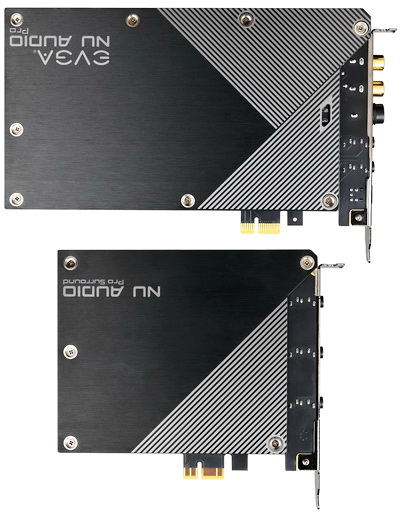
At the time of this review the only other three standalone sound cards we had in the office was the Creative Sound Blaster X-Fi Titanium HD and ZxR models and the “original” NU Audio so unfortunately, we didn't have the number of cards we'd like to in order to compare the brand new NU Audio Pro 7.1 card with. I did reach out to Creative to try and get their latest card for that exact purpose but to this date we haven't even heard back from them (and the lack of competition is really no reason to delay our review). With that parenthesis out of the way once again for our tests we used the Edifier S1000DB multimedia speaker set and the Harman Kardon NOVA stereo speaker system and two surround sound systems via the SPDIF digital output (5.1 Crystal Audio speakers - Yamaha Amplifier / 7.1 Tannoy speakers - Yamaha Amplifier). Unfortunately, we don't have enough active/powered speakers based on analog connectors to test the expansion card sufficiently (we did use the above stereo sets as a 4.0 system but that's the only thing we could do) so we focused our review almost entirely on the main NU Audio Pro card. So, the question everyone is probably wondering right now is how the new NU Audio Pro 7.1 compare to the first NU Audio card (difference between both cards and the X-Fi Titanium HD and ZxR models is very noticeable the moment you start playback of any lossless FLAC track so there’s really no need to even get into that) and the answer is that these cards are very similar and for the most part almost identical in terms of audio quality (at least with our speaker systems). Seriously now, when it comes to the digital surround SPDIF output we spend many hours trying to find differences not only in games and lossless audio tracks but also 4k Ultra HD Blu-ray movies without much luck. We did manage to hear some differences (especially with vocals and bass levels) in Hi-Res stereo model while using the Edifier S1000DB, the On2 headphones by Thinksound (sad to see that they had to close their doors) and the triple-driver headphones by 1MORE with quite a few master-grade FLAC tracks but nowhere near to what would justify moving from the NU Audio model to the NU Audio Pro model. Of course, the newly designed cover with the new three-zone RGB lighting system and the backplate could be reasons for some people but in terms of audio quality unless you plan on using the 7.1 analog surround sound expansion card the “regular” NU Audio model sounds just as good.
EVGA is known for their impeccable after-sales support and so the very first thing they did once they launched the NU Audio Pro 7.1 cards was to create an upgrade program for owners of the first NU Audio card which basically allows you to turn your card in and get the new model by paying the difference (more details here). That being said people who are looking to get the new NU Audio Pro and the 7.1 analog expansion card will have to spend USD299.99 inside the USA (EVGA) and 322Euros inside the EU (Amazon.co.uk). EVGA also sells the NU Audio Pro card as a standalone (USD199.99) if you have no need for the analog surround outputs (the 7.1 analog expansion card is also available for USD119.99). This pricing strategy by EVGA certainly helps things so even if you do own the original NU Audio model you may consider moving to the NU Audio Pro for a slightly higher cost. That being said there’s no doubt that the brand new NU Audio Pro card with its 7.1 analog surround sound companion is an impressive product and even though it may not be the best product of its kind on the face of the planet it’s certainly worthy our Platinum Award.

PROS
- Superior Build Quality
- Premium Audio Components (XMOS/ADI/AKM/Nichicon/WIMA/Audio Note UK)
- Impressive Audio Clarity / Detail
- Very Good 3D Positioning Audio
- Future Proof / Customizable (OP-AMP Rolling)
- 10 Mode Three Zone RGB LED
- Nahimic 3D Enhancements
- Upgrade Plan
- Available as Standalone Cards
- 7.1 Analog Surround Sound Outputs
- EMS Shielding Backplate
CONS
- Price (For Some)

 O-Sense
O-Sense





